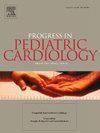与遗传缺陷相关的心血管疾病
IF 0.8
Q4 PEDIATRICS
引用次数: 0
摘要
许多基因影响心脏形态发生,并与先天性心脏病有关。一些基因突变与涉及呼吸道、肾脏、大脑和免疫系统的问题有关,这可能影响发病率和死亡率。因此,正确识别遗传疾病是很重要的。本文的目的是综述心脏胚胎学、胚胎发育中断可能导致先天性心脏病的常见形式以及可能导致畸形和临床综合征的常见遗传缺陷。在胚胎发育过程中,心脏管在妊娠早期形成并自我折叠。正确的心脏循环和侧化依赖于特定的模式通路。右-左模式通路的缺陷可能导致异交。心脏分隔术随后将心脏分成四个心室。心隔障碍包括与唐氏综合症相关的房室间隔缺损。在锥体发育过程中,流出道分为肺动脉干和主动脉。圆锥锥体发育不正常可引起动脉干、法洛四联症、主动脉缩窄或主动脉弓中断。动脉干可能与DiGeorge综合征、CHARGE综合征或VACTERL相关。法洛四联症与DiGeorge综合征和NOTCH1突变有关。主动脉缩窄与特纳综合征有关,主动脉弓中断与迪乔治综合征有关。基因检测对冠心病患者很重要,可能有助于预测心外疾病和预后。遗传学家和遗传咨询师在这个过程中很重要。本文章由计算机程序翻译,如有差异,请以英文原文为准。

Cardiovascular disease associated with genetic defects
Background
Numerous genes affect cardiac morphogenesis and are implicated in congenital heart diseases. Some genetic mutations are associated with problems involving the respiratory tract, kidneys, brain, and immune system, which may affect morbidity and mortality. Therefore, proper identification of genetic disease is important.
Aim of review
The purpose of this article is to review cardiac embryology, common forms of congenital heart disease that may occur from disruption of embryologic development and common genetic defects that may cause malformations and clinical syndromes.
Key scientific concepts of review
During embryologic development, a heart tube is formed early in gestation and folds on itself. Proper heart looping and lateralization rely on specific patterning pathways. A defect in the right-left patterning pathways may cause heterotaxy. Heart septation subsequently partitions the heart into the four cardiac chambers. Disorders of heart septation include atrioventricular septal defects, which are associated with Down syndrome. During conotruncal development, the outflow tract separates into the pulmonary trunk and aorta. Failure of normal conotruncal development may cause truncus arteriosus, tetralogy of Fallot, coarctation of the aorta, or interrupted aortic arch. Truncus arteriosus may be associated with DiGeorge syndrome, CHARGE syndrome, or VACTERL association. Tetralogy of Fallot is associated with DiGeorge syndrome and mutations in NOTCH1. Coarctation of the aorta is associated with Turner syndrome, and interrupted aortic arch is associated with DiGeorge syndrome. Genetic testing is important in patients who have CHD and may help predict extracardiac disease and prognosis. Geneticists and genetic counselors are important in this process.
求助全文
通过发布文献求助,成功后即可免费获取论文全文。
去求助
来源期刊

PROGRESS IN PEDIATRIC CARDIOLOGY
PEDIATRICS-
CiteScore
0.90
自引率
11.10%
发文量
69
审稿时长
75 days
期刊介绍:
Progress in Pediatric Cardiology is an international journal of review presenting information and experienced opinion of importance in the understanding and management of cardiovascular diseases in children. Each issue is prepared by one or more Guest Editors and reviews a single subject, allowing for comprehensive presentations of complex, multifaceted or rapidly changing topics of clinical and investigative interest.
 求助内容:
求助内容: 应助结果提醒方式:
应助结果提醒方式:


